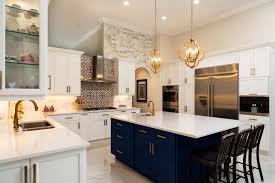Remodeling your kitchen sounds exciting—until it isn’t. Somewhere between measuring cabinets and choosing tile, many homeowners find themselves drowning in unexpected delays, budget overruns, or design regrets. What started as a dream upgrade becomes a frustrating lesson in what not to do.
The truth is, kitchen remodeling in Montgomery County is one of the most complex home improvement projects you can take on. It’s not just about making the space look better—it’s about how it functions, how long it lasts, and how well it works for your everyday life.
Below, we’ll walk through some of the most common mistakes homeowners make during kitchen renovations, and how you can avoid them. The goal isn’t just a beautiful space—it’s one that works beautifully for you.
Mistake 1: Prioritizing Style Over Function
Aesthetics Matter, But They’re Not Everything
That trending minimalist cabinet design might look great online, but will it hold everything you actually use? Glossy finishes might be stunning—until you realize they show every fingerprint, water spot, and crumb.
Designing for beauty without thinking about how the space is used day to day can lead to constant frustrations. Think about:
- How often you cook and what tools you need accessible
- Whether multiple people use the kitchen at once
- Storage for awkward items like large pots or small appliances
- Ease of cleaning and maintenance
The most successful kitchen upgrades strike a balance between style and function—where nothing is beautiful unless it also works.
Mistake 2: Ignoring the Work Triangle
Movement Should Feel Natural
The work triangle—the path between your stove, refrigerator, and sink—is a classic kitchen design principle for a reason. It ensures efficiency and flow during meal prep.
Many remodels go wrong by placing these elements too far apart, creating unnecessary steps, or even putting obstructions in between. If you find yourself weaving around an island or squeezing between appliances just to make a sandwich, the design has failed.
Before finalizing your layout, map out your typical kitchen routine. A few inches of better placement can save you years of daily inconvenience.
Mistake 3: Underestimating Lighting Needs
A Kitchen Should Never Feel Dim
Lighting is often treated as an afterthought, but in the kitchen, it plays a major role in both form and function. Poor lighting can make tasks harder, reduce visibility when handling knives or hot pans, and even make the space feel smaller.
Aim for three layers:
- Ambient lighting for general illumination
- Task lighting over work zones like counters and sinks
- Accent lighting to highlight design features or open shelving
Skipping this step might not seem like a big deal—until you’re chopping vegetables in your own shadow every night.
Mistake 4: Choosing the Wrong Materials
Looks Can Be Deceiving
Budget-friendly finishes might look good at first, but kitchens are high-use areas. Materials need to withstand heat, spills, scrubbing, and sometimes even sharp impacts.
Here’s where many go wrong:
- Choosing porous countertops that stain easily
- Selecting flooring that doesn’t hold up to moisture
- Using low-quality hinges or drawer slides that wear out quickly
Durability matters just as much as appearance. In many cases, spending a little more up front avoids costly replacements just a few years later.
Mistake 5: Overloading the Space
More Isn’t Always Better
A common instinct is to maximize every inch of space, but overstuffing a kitchen can make it feel cramped and chaotic. Oversized islands, too many upper cabinets, or bulky furniture can interrupt flow and reduce usability.
Instead, think of space planning as a balance. Leave room to breathe, walk, and cook comfortably. Consider alternatives like:
- Open shelving in place of some upper cabinets
- Pull-out storage solutions instead of deep drawers
- Compact seating that can tuck away when not in use
A minimalist approach often leads to a more usable kitchen—not a sparse one, but one that’s intelligently spaced.
Mistake 6: Not Planning for Electrical and Plumbing Realities
Behind the Walls Matters Too
You might envision your sink on the far end of the island or want to relocate the oven—but have you factored in what’s involved behind the scenes?
Moving plumbing and electrical lines isn’t impossible, but it can be expensive and time-consuming. It may also require permits and inspections, which can stall your timeline.
Work with someone who can help you understand where adjustments are realistic and where they’ll cost more than they’re worth. Sometimes, small layout shifts offer big results without the hidden expenses.
Mistake 7: Forgetting the Future
Trends Fade. Your Needs Don’t.
It’s tempting to jump on bold trends—bright colored cabinets, ultra-modern fixtures, open shelving everywhere. But what works for one era (or Instagram photo) might not hold up over time.
Instead, ask yourself:
- Will this design still feel fresh in five years?
- Is this layout adaptable if your family grows or changes?
- How easy will it be to clean or update small parts later?
A timeless kitchen isn’t boring. It’s versatile, resilient, and adaptable. It leaves room for evolution without demanding a complete do-over in a few short years.
Mistake 8: Going Fully DIY Without a Plan
YouTube Doesn’t Replace Experience
While there’s satisfaction in doing some parts of a kitchen remodel yourself—like painting or hardware swaps—trying to manage the entire project without professional input can backfire.
Common pitfalls include:
- Mismeasuring cabinets or appliance gaps
- Ordering materials in the wrong sequence
- Poorly managed timelines
- Surprise structural or code issues
Even experienced homeowners often choose to work with professionals for layout, permits, or installation. A trusted local expert like BBC Construction can help you avoid common oversights and make sure the process runs smoothly.
Mistake 9: Forgetting About Ventilation
Steam, Smoke, and Smells—Oh My
Without proper ventilation, your kitchen can trap odors, collect moisture, and become uncomfortable fast. If you’re upgrading appliances or altering the layout, make sure your ventilation plan keeps up.
Things to consider:
- Installing a range hood with sufficient CFM for your cooking style
- Venting outside (not recirculating) whenever possible
- Planning duct routes before cabinetry is finalized
It’s one of those behind-the-scenes elements that make a huge difference in everyday comfort.
Final Thought: Plan First, Remodel Second
The key to a successful kitchen remodeling project isn’t just having a clear vision—it’s about avoiding the decisions that lead to costly corrections later. From smart storage to strong materials, proper lighting to efficient layout, the best kitchens are built on thoughtful planning.
You don’t need a massive budget to create a dream kitchen—you need a solid foundation of practical choices that support the way you live. And when you’re ready to take the leap, working with a reliable professional like BBC Construction can help turn your ideas into reality without the common regrets.
In the end, your kitchen should feel like the heart of your home—because that’s exactly what it is.






